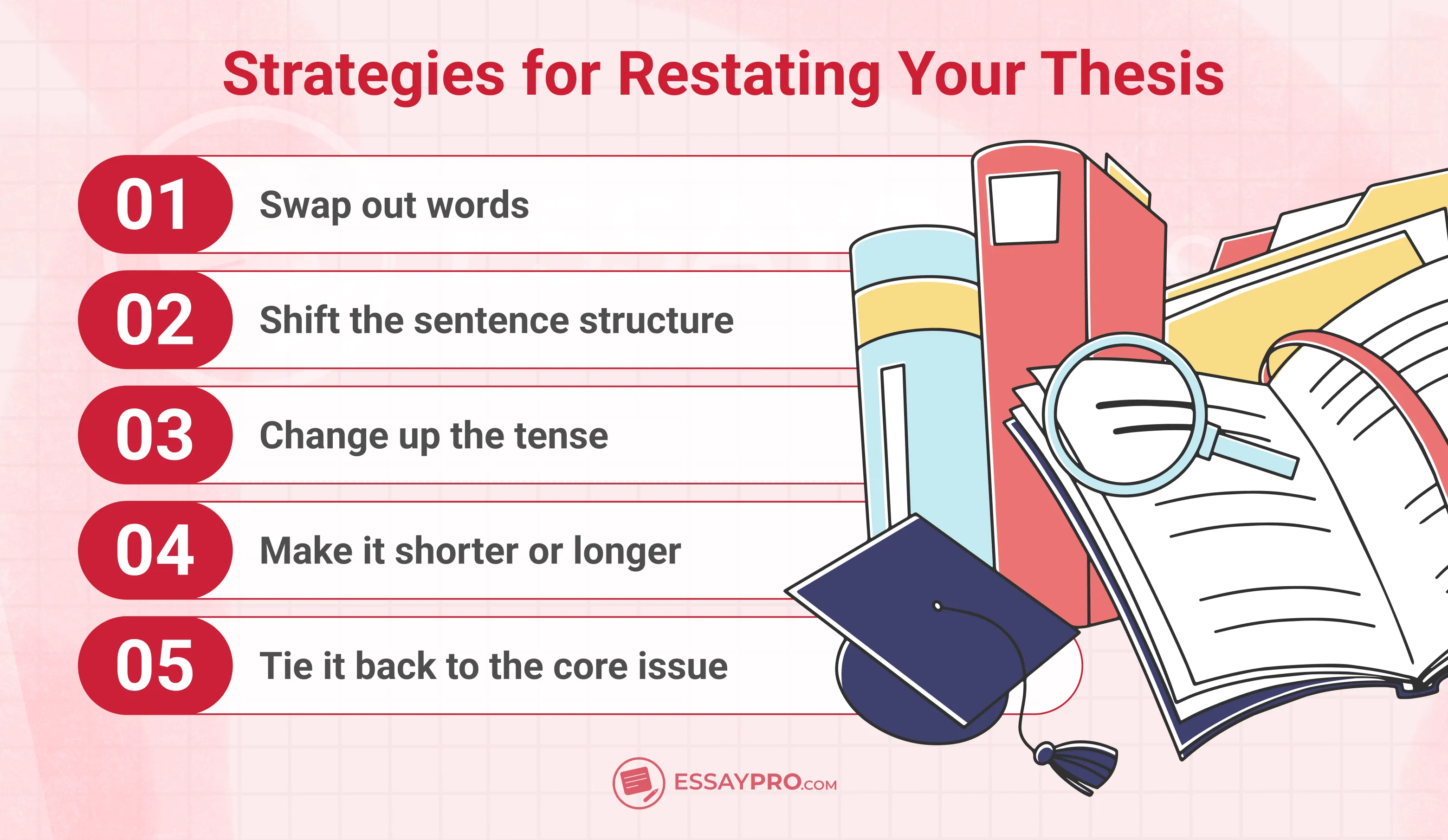Key Takeaways
- A restated thesis wraps up your argument in a fresh, clear way.
- It belongs in your conclusion, not copied, but rephrased.
- You can change wording, structure, or tense.
- Good restatements feel natural, not forced.
- They connect back to your research problem.
- Keep the meaning, just say it differently.
You usually restate your thesis at the end, right before you wrap things up. That final paragraph is your last chance to bring your reader back to your main idea and show how your paper answered it. But here’s the trick: you can’t just copy and paste your intro.
Some easy ways to do that:
- Use synonyms for keywords
- Change the sentence structure
- Shift the verb tense
- Make it shorter (or longer)
- Tie it directly to your findings
This guide breaks down how to restate a thesis clearly and simply. If you're stuck, EssayPro offers thesis writing service that can help shape or polish your thesis with expert guidance.


What Is a Restated Thesis
A restated thesis is your original main point, reworded and revisited at the end of your paper. It reminds the reader what you set out to prove, but now with the benefit of everything you’ve already explained. You’re not adding new claims. You’re circling back with clarity and a slightly new tone. The wording changes, but the core message stays the same.
Before you continue, read more about writing thesis statement.
How to Restate a Thesis
Sometimes, all it takes is a little shift in words or structure to write a restated thesis and make it feel new again. Have a quick look at the simple steps:
Different Strategies for Restating Your Thesis
Thesis restatement doesn’t mean repeating it. It means circling back, just more confidently this time.
Here’s how to restate your thesis:

Restating a Thesis Using Synonyms
This is the low-risk option. You keep the bones but update the words a bit. The point is still the same; it just wears a different outfit.
You pick the major words that stand out in your original thesis. Then you find alternatives that sound natural in the same context. Don’t overthink it or stuff in fancy vocabulary. If it sounds awkward, it’s doing too much.
- Original: Fast fashion harms the environment and exploits labor.
- Restated: The rapid production of cheap clothing damages ecosystems and relies on unfair working conditions.
Restating a Thesis by Shifting the Sentence Around
Structure makes a bigger difference than people realize. When you move pieces around, the sentence often feels fresher, even if the message doesn’t change.
- Change the order.
- Split it in two.
- Merge a pair into one.
- Original: Remote work improves productivity by giving employees more control over their schedules.
- Restated: By allowing flexible schedules, remote work often leads to better productivity.
Restating a Thesis with a Tense Change
You’re in the conclusion now. The work is done. So it makes sense to reflect with a different verb tense. This softens the tone and makes your final statement feel like a wrap-up.
Take your present-tense claim and shift it into past or present perfect. Keep it consistent with the rest of your conclusion.
- Original: This study proves that social media increases anxiety in teens.
- Restated: This study has shown that social media contributed to increased anxiety among teens.
Restating a Thesis by Making It Longer (or Shorter)
Some conclusions need a tight ending. Others need a bit more explanation. You can adjust your thesis to fit.
Cut the extra fluff if the message is already clear. Or add a key detail that ties your argument to the evidence. Just don’t lose your tone in the process.
- Original: Exercise improves mental health.
- Restated (short): Exercise boosts mood.
- Restated (long): Regular physical activity improves mental health by reducing stress and supporting emotional balance.
Restating a Thesis by Reconnecting It to the Bigger Problem
This one’s about purpose. If your thesis grew from a problem you introduced early on, bring it back around. Let your final version respond directly to that issue. That’s what makes the restated thesis feel satisfying.
- Original: Public transportation reduces traffic and pollution in cities.
- Restated: As urban areas struggle with congestion and air quality, this research highlights how improved public transit can offer a real solution.
How to Reframe a Restated Thesis
Once you’ve got your thesis down, you still need to shape it so it fits your conclusion. It can’t just sit there, copied and pasted. You’ve got to reframe it, shift the tone, match the flow, and make sure it connects back to the bigger picture. This final touch helps your essay feel complete, not just technically finished.
Here’s how restating your thesis will go:
- Lead into your restated thesis with a transition or reflective sentence
- Match the tone of your conclusion, more reflective, sometimes broader
- Keep it brief but purposeful, don’t just repeat your points
- Tie it back to your paper’s opening problem or big idea
Extra Tips for Restating Your Thesis
Rewriting a thesis in the conclusion isn’t about rewording for the sake of it. It’s about making your final message land. A good restatement sounds fresh but still familiar. It reminds your reader of the point you’ve been building up to without sounding like a copy of your introduction.
Here are a few tips to get it right:
- Rethink the sentence as a whole
- Avoid introducing new information or claims
- Keep the tone consistent with the rest of your conclusion
- Consider what your paper has proven, not just what it posed
- Start with a transition phrase
- Try to echo the same message in a tighter, more resolved way
- Read your restatement out loud
Why Restating Your Thesis Is Necessary
Restating your thesis pulls everything together at the end of your paper and helps your conclusion land with clarity. It reminds the reader what your core idea was, now backed by evidence. These seemingly small steps make a big difference.
Reasons to restate your thesis:
- Brings focus back to your main point
- Helps the conclusion feel complete and purposeful
- Shows how your argument developed through evidence
- Connects the introduction and conclusion smoothlyLeaves a strong final impression
- Reinforces your message without sounding repetitive
The Bottom Line
A thesis gives your paper a full-circle ending. When done right, it strengthens your message and helps the reader walk away with your core idea clearly in mind.
- A restated thesis is reworded, not repeated
- It appears in your conclusion and reflects what your paper has shown
- There are many ways to rephrase: through synonyms, structure, or linking to your findings
- Keep the tone and meaning consistent
- The goal is to remind, not repeat
If you're wrapping up a paper and need help finding the right words, EssayPro has your back, from strong thesis crafting to full essay support.
Deadlines Don't Wait!
Get expert help with essays, research papers, and everything in between.
FAQs
What Does Restate Thesis Mean?
It means rewriting your thesis statement in the conclusion using different words, while keeping the same main idea.
How to Restate a Thesis Without Repeating?
Change the sentence structure, swap out key words for synonyms, and reflect on the research findings to shape your phrasing.
When You Rewrite a Thesis, Do You Rephrase It?
Yes. You keep the message but say it in a new way so it fits naturally in the conclusion.

Mariam Navrozashvili
She has a Master’s degree in English Literature and brings a deep understanding of storytelling, critical analysis, and language structure to her work. On EssayPro Blog Mariam writes guides on literary analysis, essay composition and language studies to help students improve their writing skills. In her free time she likes to read classic novels and discuss literary theory.
The Writing Center. (n.d.). Thesis statements. University of North Carolina at Chapel Hill. https://writingcenter.unc.edu/tips-and-tools/thesis-statements/







